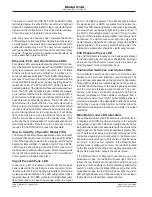
Model 214A User Guide
Issue Preliminary 1, October 2022
Studio Technologies, Inc.
Page 7
Model 214A
ANNOUNCER’S CONSOLE
rooms and provide one channel of program-with-interrupt
audio and a second channel with program-only audio. The
third, fourth, and fifth configuration modes allow all four of
the Dante-provided audio sources to be utilized. These
can be useful for more complex or specialized situations.
The three headphone level controls (“rotary pots”) are
provided for setting the “mix” of the selected audio input
sources as well as adjusting the overall headphone output
level. How these controls function depend on the selected
headphone mode. The first mode can be used to support
traditional on-air sports applications. In this mode, it would
be typical to route (Dante subscribe) program-with-interrupt
audio to the Dante receiver (input) channel 1 and pro-
gram-only audio to the Dante receiver (input) channel 2.
Rotary control A, located on the left side, is used to adjust
the level of the program-with-interrupt audio signal that’s
routed to the left headphone output channel. Rotary control
B, located in the center, is used to adjust the level of the
program-only audio signal that’s routed to the right head-
phone output channel. For use with dual-channel or stereo
cue signals, another headphone output mode provides a
stereo (“level/balance”) mode. In this mode, rotary control
A adjusts the level of both Dante receiver (input) channels
1 and 2, while rotary control B allows adjustment of the left/
right level balance. In both of these modes, rotary control
C, located on the right side, is used to adjust the level of
the sidetone audio signal that can be sent to both the left
and right headphone output channels.
When selected for the third headphone output mode rotary
control A adjusts the level of Dante receiver (input) channel
1 as it is sent to the left headphone output channel and
Dante receiver (input) channel 2 as it is sent to the right
headphone output channel. Rotary control B provides the
same function for Dante receiver (input) channels 3 and 4.
Rotary control C adjusts the sidetone level.
The fourth headphone output mode offers another unique
routing choice. Rotary control A adjusts the level of Dan-
te receiver (input) channel 1 as it is sent only to the left
headphone output channel. Rotary control B adjusts the
level of Dante receiver (input) channel 2 as it is sent only
to the right headphone channel. Rotary control C adjusts
the level of Dante receiver (input) channels 3 and 4 as
they are sent, respectively, to the left and right headphone
output channels.
The fifth headphone output mode is similar to the fourth,
with the exception that Dante receiver (input) channel 1 is
sent to both the left and right headphone output channels;
Dante receiver (input) channel 2 is sent to both the left and
right headphone output channels.
The sidetone function allows audio from the output of the
Model 214A’s microphone preamplifier to be sent to the
left and right headphone output channels. This can be
useful, providing the user with an aural confirmation of
the signal connected to the microphone input. This ability
can be especially important when a “mix-minus” talent cue
signal is provided for the user. For application flexibility,
the sidetone function can be configured from among four
choices, specifying when it will be active in relation to the
status of the main and talkback functions. It can also be
disabled if desired.
To help minimize the chance of broadcast cues being
missed, the action of the rotary level controls can be
configured so that there’s always a minimum headphone
output level. Alternately, the rotary controls can be config
-
ured to fully mute when the controls are at their minimum
(fully-counterclockwise) position. When the rotary level con-
trol on the right side, labeled C, is configured for sidetone
use it will always allow the sidetone signal to be fully muted.
The 2-channel (stereo) headphone output was designed to
meet the needs of contemporary headphones and head-
sets. Specifically, the two output circuits act as voltage
drivers rather than power drivers. In this configuration,
they can provide high output levels with very low distortion
and noise, along with minimal current consumption. With
the Model 214A, all types of headphones, headsets, and
earpieces can be directly connected.
A configuration feature allows the overall headphone output
gain range to be selected. The low setting is appropriate for
most applications where users need to listen at moderate
levels. The high setting can be useful when monitoring at
higher levels is warranted by an application.
Dante Audio-over-Ethernet
Audio data is sent to and from the Model 214A using the
Dante audio-over-Ethernet media networking technology.
For flexibility in meeting a variety of application and sonic
requirements, bit depths of up to 24 and sample rates of
44.1 and 48 kHz are supported.
Audio transmitter (output) and receiver (input) channels on
associated Dante-enabled devices can be routed (Dante
subscribed) to the Model 214A using the Dante Controller
software application. This makes selecting the way in which
the Model 214A fits into an application a simple matter.
For example, the Dante main transmitter (output) channel
can be routed to the Dante receiver (input) channel of an
audio console. The Dante talkback transmitter (output)
audio output channel could be routed to a Dante receiver
(input) channel on a matrix intercom system. The Dante
aux transmitter (output) channel, when configured for hot
mic, could be routed directly to an amplified speaker for








































